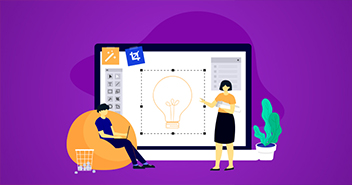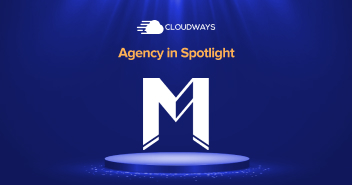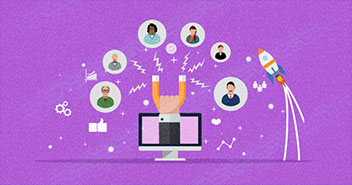
Once you have an agency with four to five clients, things get real. You realize that each client has different needs, which can take a toll on you. And, of course, things will continue to tense up as you acquire more clients.
As a result, you may get roadblocks, late deliverables, longer work hours, an unsatisfied workforce, etc. But establishing agency processes from the get-go can keep things efficient and manageable for you.
With some solid agency systems in place, you can perform better, utilize the resources efficiently, and even have more profits.
This article will help you get there.
Below, we’ll see how to build agency processes that deliver results and, eventually, better profits!
What are Agency Processes?
Agency processes are management systems with a beginning and an endpoint.
They are used to run your operations at every level, including planning, execution, completion, and follow-up. This helps with the execution of your unique workflow to achieve your goals and grow simultaneously.
Michael Gerber, the author of the famous The E-Myth Revisited, writes the following about processes:
“If you are going to create a business that serves your life, you must create an organization that will stand on its own. You need a model that is systematized so that it functions the same way every time.”
Along with the methods, we have also included expert opinions from successful agency owners who have taken their businesses to the next level by building, documenting, and optimizing processes at their agencies.
Learn from their examples and get serious about systemizing your workflows today.
How to Build Your Agency Processes
The following steps can help you build workable agency processes:
1. Process Prioritization
Start by listing out everything you do in your agency. Walk in the steps of any potential client and map out their journey of interactions and actions executed by your team.
It will include a list of complete deliverables, including the project milestones, challenges faced interaction with stakeholders, etc. Just get everything possible that you’ve created and delivered. Also, put a time window on it.
Look at the last six months’ work, pull up the contracts you have signed, and create the list.
Then, go through that list and measure three categories in each process on a scale of one to five.
- How frequently do you go through this process as a team, and how well do you understand its steps?
- How complex is this process, and how many outside systems need to be plugged into this?
- How painful is this process right now for you to carry out?
Once ready with your list, prioritize (with a scale from 1-5). It will show you your most painful processes and those that need to be developed as you’ll frequently use them and don’t want to waste time and resources every time.
Alex Contes, Co-Founder & SaaS Expert of *ReviewGrower* expressed his views as

Create a flowchart of your processes from beginning to end to pinpoint bottlenecks, redundant procedures, difficult obstacles, and inefficient use of team members’ time. Determine the present ins and outs of your company’s strategy so you can spot the areas where you’re losing time and where you may make improvements.
Bowart Wolfe, an ecommerce store manager, and CEO:

At my agency, we developed processes through a combination of brainstorming sessions, research, and feedback from our team. We documented these processes by creating detailed process diagrams and flowcharts. This allowed us to have a clear understanding of how the processes should work. we incorporated feedback from stakeholders into our development process, enabling us to make adjustments where necessary to improve efficiency. Through this approach, we could create robust and well-functioning processes tailored to our unique environment. Additionally, this helped streamline operational activities within the agency resulting in increased productivity and cost savings.
2. Set Goals
Goals are essential for giving structure to your processes.
In addition to setting larger-picture goals, such as deliverables and meeting client needs, you should also set benchmarks and milestones that will be used to evaluate your progress along the way.
Many organizations use the SMART method to set actionable, deadline-driven milestones. This structure is described briefly below:
Specific: Make sure every goal is narrow and contained. Think, “save on monthly overhead costs,” not “generate more revenue.”
Measurable: How will you evaluate if you are making progress? It would help if you had specific agency metrics to ensure your success.
Attainable: Goals should be achievable reasonably, and don’t set unrealistic goals. They should always be selected, keeping in mind your past position.
Relevant: The goal needs to align with the agency’s long-term objectives. For example, if an agency wants to grow on social media, it should think of activities to increase followers.
Time-based: The goal is only considered SMART when it is time-bound, e.g., achieving 3x followers in 6 months.
Jaden Oh, Director of Search at *TRAFFV* explains,

Understanding agency procedures and being willing to put in the effort required to achieve goals are critical to success. They are able to foresee potential roadblocks, plan accordingly, and ultimately succeed. The SMART method is the most effective strategy for establishing objectives.
Resell Hosting to Maximize Your Recurring Revenue and Profit
With Cloudways, you can sell top-notch managed hosting to your clients at a price of your choice.
3. Have Your Tech Stack Ready
When setting up your agency processes, you will need to leverage time-saving tools to help.
Your team will have to navigate the most common functions, from generating leads to closing clients, billing and briefing them about the project, and ultimately jumping to actual work and deliverables.
Phew!
That’s a lot of processes involved. But once you have the right tools and software ready in your tech stack, you will be better at building and streamlining your processes.
Tools used for some of the agency functions are:
- Project Management: Monday.com, Trello, Airtable, Teamwork
- Communication: Slack, Google Chat, and Microsoft Teams
- Sharing Documents and Materials: Google Drive, OneDrive, Dropbox, and WeTransfer
- Meeting: Calendly, Zoom, CalendarHero, Google meet
- Client Management: Proofhub, Hubspot
- Billing Software: Freshbooks, Xero, Wave, Quickbooks
Jerry Han, CMO at PrizeRebel, talks about tools that help them:

We experienced communication barriers, productivity issues, and tech struggles prior to improving our process. Work was pretty hectic as we sought to bring projects to completion across many different time zones. Asana and Zoom increased our effectiveness in reaching deadlines consistently and adding new customers. They helped us streamline our collaboration, which has also made us more agile in responding to outside circumstances.
4. Set Team Structure
Now that the Agency process is spelled out, it’s time to determine the following:
Who does what, and to what extent? What are the roles and responsibilities of your team? Individuals already have titles like creative director, project manager, copywriter, marketing manager, etc.
How a project is structured determines the need to identify the core team to be involved throughout.
Also, there should be clear direction on reporting relationships. It is important to involve your team in process creation because the more they are involved, the more ownership they will have over them.
This is where you can really delegate to your team to build out your agency processes and maintain them without involvement in every part of it.
Get High-Converting Client Proposal Samples
Avoid the legwork of creating templates and process documents for your agency with our useful collection of templates, designed to help you streamline and better manage core agency processes. You can download one, or all templates for free in the form of our Agency Resource Pack.
Document Your Processes
If a process is rolled out without proper documentation, it risks poor implementation, effectiveness, and measurement.
What to Document?
It’s important to document the processes you build along the way. You should document
- A description of each step in your workflow
- The order in which those steps should be completed
- The tools and resources you’ll need for each step
- Who is responsible for each task
- When tasks should be complete
Write all the inputs and outputs. This will help you hone your processes so that you can reuse them and improve upon them.
How to Document?
Things to consider to find the suitable format for documenting your agency’s processes. Ask these questions before you jump into writing:
- How detailed should your document be
- What format do your team members prefer
- Who will be improving the process
- Who will be part of the documentation writing
You can document processes for the following:
- How you create your email campaign
- How you post on social media
- How to handover deliverables
- How to onboard new clients
- How to bill your clients
- Any software or tools you use (in most cases, you can link from your process to the welcome videos or support content for the relevant tool)
Format of the Document
You can document in many different ways like:
- Visual documentation – Creating charts and graphs depicting a process’s flow.
- Screenshots – Take screenshots of software that outlines the functionality and purpose of each function.
- Screen record -screen-recording is the best method to document any complex web build process
- Sketching/Drawing – Drawing sketches of a process with accompanying descriptions.
- Text/Word docs – Writing out the process with accompanying descriptions
After Documentation
You can keep a monthly or quarterly accountability check for your team to see if they are following the process.
Documenting isn’t a done-and-dusted approach; you must keep updating it with changes in your workflow and new tools entering your tech stack.
Basically, whatever you do that adds value to your business – document it! So if you get sick, someone could easily take over. If you have employees, ask them to document their processes as well and keep them maintained.
Abdullah Ali, the cofounder at Coding Pixel, shared his thought about documenting processes as:

Process documentation should be a collaborative, introspective exercise. You need to get process owners involved and ask them to map their current vs. industry-standard practices. The first step in the documentation process is to list what you do vs. what’s accepted as standard practice in the industry and then start making the changes. You must ask your employees to document all the workflows. This is followed by creating templates for the documentation process that everyone in your agency can access. Such as a new employee should be able to complete a task using these templates.
YigitKonur, founder of a digital agency Wope,

Once I had developed the processes, I documented them in a central repository. This allowed our team to easily access the processes and follow them when needed. I also created a system of checks and balances to ensure that the processes were being followed correctly. This included regular reviews of the processes and feedback from our team on how they could be improved. we have internal docs and videos for each of our processes, and each process is managed in our project management platform.
Watch Lee Mathew Jackson here, where he explains the “Document as you go” approach.
Review and Optimize Processes:
Once you have established core processes at your organization, it is important to review — and keep reviewing — the procedures you’ve set up. After all, what worked once won’t work forever, so you must ensure that your procedures remain relevant and necessary. Pay attention to any duplicate or redundant efforts to maximize efficiency, too.
James De Roche, the owner of Lead Comet, explains:

We’re huge on process optimization at Lead Comet. You have to follow numerous steps to run an SEO audit. That’s why we track everything in Basecamp. We have every one of our sprints mapped out in full. Each time we get a new client, we launch a new project and assign tasks to our team directly from there. This ensures that we miss nothing and deliver the highest level of service. Finally, after every sprint, we ask team members to share their ideas on process improvements. We use those to adjust our strategy and better serve our clients.
EdwardSolicito, CEO, To The Top Agency talks about streamlining process at their agency as:

We decided to streamline our onboarding process by creating a detailed welcome packet that walks new clients through our services step-by-step. This has been extremely helpful in getting new clients up-to-speed quickly and efficiently. It has also saved us a lot of time, which we can now use to work on other projects. Overall, this has been a huge win for both our clients and us!
Matthew C. Egan, Chief Content Officer from Image Freedom talks about processes as,

We built different processes to match the project management style of each client. Some clients are very hands off, so our processes are only documented internally, but some clients want to review every line that goes out on their website so we use a shared Google Doc and edit content collaboratively so the client had the chance to sign off on every letter.
Most agency owners believe that unoptimized SOPs are the biggest growth challenge. Thus, while you review, you must keep optimizing the processes you have built for smooth functioning.
Join Our Agency Partnership Program to Supercharge Your Agency Growth
Want to streamline your agency processes and know what tools and platforms can boost your agency’s growth? Join our agency partnership program for all of this and enjoy discounts, co-marketing opportunities, and more!
Wrapping up:
Building agency processes can make you efficient and confident in your work. But you can’t figure it out all at once.
And that’s okay. The journey is ever-going. But having a baseline process for operations will be super helpful for the agency.
And, of course, there’ll be changes in those work models as you grow. There’ll be so much to add and subtract. So don’t feel like it’s something you get done once, and then it’s done forever.
Let me know in the comments what processes your business does well. What processes do you need to improve the most?
Fatima Muhammad
Fatima is a Digital Marketer at Cloudways. She believes consistency coupled with hard work is the perfect recipe for success. She loves to read, cook, watch Netflix, and spend time with her beautiful daughter.


